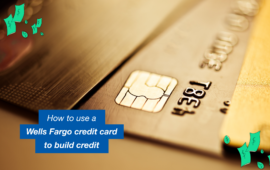Strategies and Tips to Pay Off $50,000 of Debt in One Year
About Anouare
Anouare is a seasoned writer, editor and content strategist who started her career as a lifestyle journalist before stepping into leadership roles at publications such as AskMen and Goalcast. From editorial strategy to content marketing and project-management, she has tackled various challenges in digital media and discovered her passion for mentoring others in the process. She loves a good money mindset book and believes you can create your dream lifestyle by being yourself.
Read full bio
At a Glance
Household debt grew by $305.1 billion in the third quarter of 2021. As an individual, you may be ready to take on drastic measures to pay off your debt very quickly. Now, imagine paying $50,000 of debt in one year. If it sounds crazy, don’t discount the idea just yet. With strategy and discipline, it may just be possible for you.
“The average person may be able to pay off a huge amount of debt that is owed within a year if they are committed to maintaining their budget and careful with their spending,” says Chris Panteli, finance and investment expert and founder of LifeUpswing.com.
For example, if you spend $2,000 on groceries every month and decide to halve that amount through meal-planning and shopping in bulk and on sale, you’d have put aside $12,000 to put towards debt by the end of the year. It’s a good start. But you’d need other efforts too.
“An individual with $50,000 in debt would need to pay an average of $8,333.33 per month to pay that debt off in one year. They would need to be able to allocate that much money for paying off their debt each month, and also have enough available funds each month to pay the minimum amount required under their repayment plan,” says Panteli.
$1.079 trillion
Is Americans’ total credit card balance for the third quarter of 2023, according to the latest consumer debt data from the Federal Reserve Bank of New York.


Ways to pay off $50,000 of credit card debt
1. Debt consolidation
The debt consolidation method for reducing debt is an excellent strategy for paying off debt. This involves moving your existing debt from one current source to another, ideally with a lower interest rate. Having the lower interest rate will result in more organized debt by reducing the number of payments you have to remember on a monthly basis, but it will also hopefully reduce the cost of your debt as well.
Debt consolidation loans offer the opportunity to simplify your debt, potentially reduce interest rates, and expedite the path to financial freedom by consolidating high-interest debts into a single, manageable payment plan.
Find and compare the best debt consolidation loan options.
Use the filters below to refine your search

Sorry, we didn’t find any options that meet your requirements. Please try modifying your preferences.
Congratulations! You’re close to seeing your offers!
Please take a second to review the details you shared earlier
Sorry, we didn’t find any options that meet your requirements. Please try modifying your preferences.
You have options. No two debt consolidation strategies will be the same and each will come with their own pros and cons. Evaluate all of the factors before choosing where to consolidate your debt.
Learn more: Best Ways to Consolidate Debt
2. Debt snowball method
The debt snowball method focuses on paying off debts in order of smallest to largest, with the idea that you gain momentum as you eliminate debt one at a time. Start by paying off your smallest debt first (not including your mortgage) while making minimum payments on all of your other balances. Once the smallest debt is paid off, begin paying off the next smallest, and so on until you’re debt-free.
Learn more: Debt Snowball Method
3. Debt avalanche method
The debt avalanche method has you prioritize paying off balances with the highest interest rates. Make the minimum payments on all of your other balances, but put all extra toward the one with the highest interest. Once that’s paid off, move on to the next-highest interest debt, and so on until it’s all paid off.
Learn more: Debt Avalanche Method
Tips to pay off $50,000 of debt in a year
Here are a few tips to tackle a $50,000 debt in the span of a year.
1. Create a budget and track your income and spending
Create a detailed budget for all your fixed expenses, says Jonathan Svensson, the co-founder of Almvest, a financial education resource. These include things like your rent or mortgage, utilities like the electricity or the internet, car payments, etc. He recommends using a free app like Mint to understand your spending with convenient online tracking tools.
“By understanding your fixed income versus your fixed expenses, you can cut out unnecessary spending on things like going out to eat, going to the movies, ordering Starbucks every morning, and so on,” he says.
2. Be mindful of debt fatigue
Being so strict puts you at risk of a phenomenon called “debt fatigue,” so it’s important to be aware that it exists. Basically, you don’t want to put yourself in a situation where you become financially unstable and give up on paying your remaining debt, says Panteli. Save some money for some of your day-to-day expenses and approach your debt repayment strategy like a marathon, not a race.
3. Prioritize paying high-interest debt first
“Prioritize your debts and pay off the highest interest rate debt first. Instead of making minimum payments on all your debts, try putting as much money as you can towards paying down your highest interest rate loan/debt until it’s gone,” recommends Svensson. Then, move on to the next highest-interest balance, and so on.
“This way you’ll be saving yourself from wasting money due to high-interest rates by eliminating that from the equation early on in the repayment plan.”
4. Get a higher-paying new job
The job market is hot, so it’s the perfect time to take advantage of it. A pay jump can help you drastically turn around your financial situation when combined with a reduction of unnecessary expenses.
5. Freelance on the side
Finally, start a side hustle in addition to your full-time job, says Svensson, who suggests using sites like Upwork and Fiverr to find freelance opportunities.
“This could be anything from digital marketing to customer service to admin support to writing. If you have a specialized skill, there’s likely someone on these sites willing to pay for it. If you find yourself with a lot of extra time, turn that time into money instead of watching Netflix,” he adds.
Related: Best Side Hustles to Pay Off Debt
6. Negotiate with your credit card companies and other creditors
If you’re drowning in credit card or other types of debt, contact your creditors to see if they have any repayment or forgiveness options available. For example, they may be willing to set up a payment plan with lower monthly payments. Or, they may forgive some of your debt if you’re able to pay a larger chunk of it off at once. Let them know you’re struggling with your payments and ask if there’s anything they can do to help.
Additional options for paying off $50k in credit card debt
1. Home equity loan
If you have equity in your home, you could consider a home equity loan (HEL) as an option to pay off debt. These loans are essentially a second mortgage and provide some cash you can use to pay off higher-interest debt, typically at a lower interest rate. The loan amounts are based on the difference between the home’s current market value and the mortgage balance due.
The primary downsides to HELs are closing costs and fees, and you risk losing your home if you don’t stay on top of payments.
2. Balance transfer
With a balance transfer, you move your existing credit card debts to another card, ideally that has a lower interest rate. In fact, some balance transfer credit cards offer a 0% APR introductory period where you won’t pay interest on the balance for a certain period of time (typically 12-24 months). While a balance transfer fee will apply and you’ll need to ensure you can pay off the balance in full before the intro period ends, this can be a good way to pay down debt quickly.
Look into debt relief options
1. Debt management plan
A debt management program (DMP) is a plan provided by credit counseling agencies to help people better manage their finances through education and counseling. The non-profit organization assigns counselors to people who are in debt, who then provide advice and guidance and help negotiate with creditors to develop a reduced payment plan. Sometimes they are able to lower interest rates, waive fees, or decrease the total debt owed.
Note there’s typically a fee for these services and you’ll be required to close all of the accounts under the DMP to avoid racking up more debt, which can hurt your credit score.
2. Debt settlement
Debt settlement is when you negotiate with your creditors to pay less than what you owe on your accounts. It’s typically done through a debt settlement company (for a fee), but this option should be carefully considered because it can do major damage to your credit score. You’ll be making payments to the debt settlement company until you’ve reached an amount the company can use to negotiate, which can take time. In the meantime, you’re typically instructed to stop making payments on your accounts, racking up late payment fees and bringing down your credit score.
3. Bankruptcy
Bankruptcy should be considered a last resort with your debt, but if you’re not able to pursue any other path, bankruptcy may be your only option. There are different types of bankruptcy, each taking different periods of time to resolve and having different restrictions. It can also do serious damage to your credit score, so if you’re considering bankruptcy, consult with a credit counselor or bankruptcy attorney to decide if it’s right for you.
What to do after you pay off $50,000 in debt?
Paying off your debt is a huge success, and you should definitely take a moment to acknowledge and responsibly celebrate this accomplishment. Then, you should:
- Build an emergency fund: Establish or bolster your emergency fund. Aim for three to six months’ worth of living expenses. This fund provides a financial safety net, protecting you from unexpected expenses and helping you avoid falling back into debt.
- Stick to your budget: You created a budget as part of paying off your debt, and now it’s time to stick to it. Keep an allocation for essential expenses and savings, but build in some room for occasional splurges. Instead of putting it on your credit card and adding to debt, treat yourself every once in a while with money you’ve set aside for that purpose.
- Avoid closing credit cards: Now that you’ve paid your credit cards off, it can be tempting to close them to avoid overspending and going back into debt in the future. However, keeping old credit cards open can actually help keep your credit utilization ratio low, helping your credit score.
- Create new financial goals: Since you’ll no longer be putting money towards debt each month, it’s time to allocate that money towards your other financial goals. This could be savings, retirement, or investments. Automate the savings so that you aren’t tempted to spend that money.
The benefits of paying off all your debt in a year
First, arm yourself with motivation. There are massive benefits to pulling off such an ambitious debt repayment plan. “Some of the benefits include improved credit score, improved interest rates on new loans or lines of credit, and improved self-esteem,” saysPanteli.
“A major motivation for people with substantial amounts of credit card debt is the high interest rates they are paying on their loans,” he adds.
“These loans often carry an annual interest rate higher than 20%. For example, if you owe $10,000 on your credit card and the balance carries an annual interest rate of 29%, you will be charged $2,900 in interest each year.”
Bottom line
No one is saying paying off a large amount of debt like $50,000 in what is considered a short amount of time is going to be easy, but it is possible. You have to be disciplined and accept that there are just certain things you aren’t going to be able to do during this time period. But in the long run, being debt-free will be the ultimate reward.
FAQs
Paying off $50,000 in debt can either be a fixed time frame, such as if the debt is from a loan with an established tenor, or it can be a lengthier process if it’s credit card debt. After all, putting $1,000 towards that debt on a monthly basis means that it would take 50 months, or just over 4 years, to pay off the debt not including any interest.
Considering that the average American has around $8,000 in debt, having $50,000 in debt would be considered a large amount. With that said, paying off $50,000 is certainly not impossible despite the fact that it may feel that way at certain points.
To pay off a $50,000 loan quickly will require using a number of different repayments strategies all at once. Debt consolidation combined with the debt snowball method can help a person start to make payments on their debt so that they get in the habit, then the amount repaid can gradually increase monthly.
Related: How to Pay Off Debt Fast?








